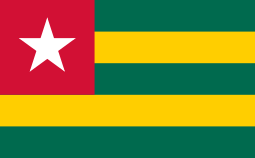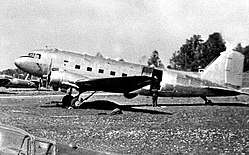List of accidents and incidents involving the DC-3 in 1974
This is a list of accidents and incidents involving the Douglas DC-3A that have taken place in 1974, including aircraft based on the DC-3 airframe such as the Douglas C-47 Skytrain and Lisunov Li-2. Military accidents are included; and hijackings and incidents of terrorism are covered, although acts of war are outside the scope of this list.
January
A C-47A of the Força Aérea Portuguesa



.svg.png)

.svg.png)

February


April

A RAAF Dakota
.svg.png)


May


July

August
.svg.png)
.svg.png)

September

October

A Tp 79 of the Svenska Flygvapnet
A Douglas C-47 of Projeto Rondon



.svg.png)

November


.svg.png)

.svg.png)
December

.svg.png)
gollark: Does it handle leap years correctly?
gollark: I also want <@377469266372591616> powers.
gollark: ↑
gollark: Okay. I will try and calculate™ what it is later.
gollark: Is it related to some sort of programming thing?
See also
- List of accidents and incidents involving the DC-3 in the 1970s
References
- "6161 Accident description". Aviation Safety Network. Retrieved 23 August 2010.
- "HK-1216 Accident description". Aviation Safety Network. Retrieved 23 August 2010.
- "TAM-30 Accident description". Aviation Safety Network. Retrieved 23 August 2010.
- "PK-GDC Accident description". Aviation Safety Network. Retrieved 23 August 2010.
- "5V-MAG Accident description". Aviation Safety Network. Retrieved 23 August 2010.
- "CF-TVK Accident description". Aviation Safety Network. Retrieved 23 August 2010.
- "FAC-960 Accident description". Aviation Safety Network. Retrieved 23 August 2010.
- "Accident description". Aviation Safety Network. Retrieved 23 August 2010.
- "HK-1333 Accident description". Aviation Safety Network. Retrieved 23 August 2010.
- "ADF Aircraft Serial Numbers RAAF/RAN A30/A65/N2; Douglas C-47, C-49, C-50, C-53, DC-2 and DC-3". ADF Serials. Retrieved 1 August 2010.
- Wilson, Stewart (1990). Dakota, Hercules and Caribou in Australian Service. Weston Creek, ACT: Aerospace Publications. p. 62. ISBN 0-9587978-5-4.
- "XW-TFL Accident description". Aviation Safety Network. Retrieved 23 August 2010.
- "HJ254 Hull-loss description". Aviation Safety Network. Retrieved 23 August 2010.
- "HC-AUC Accident description". Aviation Safety Network. Retrieved 23 August 2010.
- "XW-TFN Accident description". Aviation Safety Network. Retrieved 23 August 2010.
- "XW-PKT Hull-loss description". Aviation Safety Network. Retrieved 23 August 2010.
- "C-FTAT Accident description". Aviation Safety Network. Retrieved 24 August 2010.
- "ET-ABE Accident description". Aviation Safety Network. Retrieved 24 August 2010.
- "HK-508 Accident description". Aviation Safety Network. Retrieved 24 August 2010.
- "BJ920 Hull-loss description". Aviation Safety Network. Retrieved 24 August 2010.
- "Accident description". Aviation Safety Network. Retrieved 24 August 2010.
- "XW-PKX Accident description". Aviation Safety Network. Retrieved 24 August 2010.
- "79005 Accident description". Aviation Safety Network. Retrieved 24 August 2010.
- "Accident description". Aviation Safety Network. Retrieved 24 August 2010.
- "RP-C643 Accident description". Aviation Safety Network. Retrieved 24 August 2010.
- "N76 Hull-loss description". Aviation Safety Network. Retrieved 24 August 2010.
- "TAM-34 Accident description". Aviation Safety Network. Retrieved 24 August 2010.
- "FAB2050 Accident description". Aviation Safety Network. Retrieved 24 August 2010.
- "Accident description". Aviation Safety Network. Retrieved 24 August 2010.
- "ET-AAR Accident description". Aviation Safety Network. Retrieved 24 August 2010.
- "XW-TFI accident description". Aviation Safety Network. Retrieved 4 August 2010.
- "PK-RDB hull-loss description". Aviation Safety Network. Retrieved 4 August 2010.
- "Census of surviving DC-3s in Australia". Adastron. Retrieved 1 August 2010.
Notes
^Note A Military versions of the DC-3 were known as C-47 Skytrain, C-48, C-49, C-50, C-51, C-52, C-53 Skytrooper, C-68, C-84, C-117 Super Dakota and YC-129 by the United States Army Air Forces and as the R4D by the United States Navy. In Royal Air Force (and other British Commonwealth air forces') service, these aircraft were known as Dakotas.
This article is issued from Wikipedia. The text is licensed under Creative Commons - Attribution - Sharealike. Additional terms may apply for the media files.